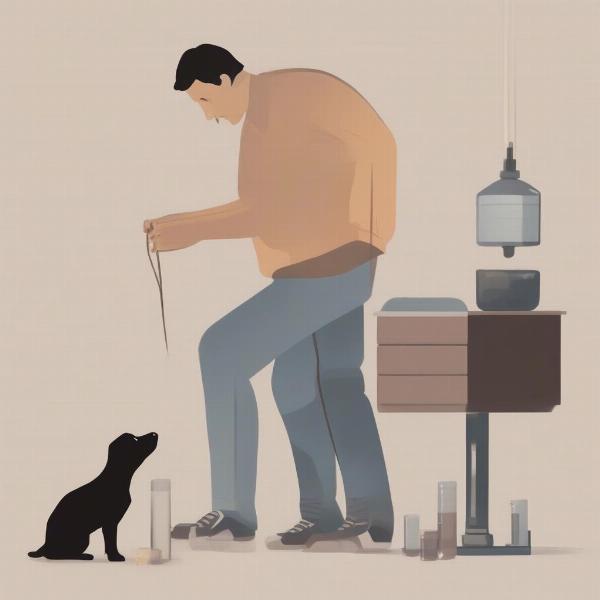A low residue diet for dogs is designed to be easily digestible and minimize the amount of undigested food that passes through the digestive tract. This specialized diet can be crucial for dogs experiencing various gastrointestinal (GI) issues. It’s essential to understand the purpose, benefits, and proper implementation of a low residue diet to support your dog’s digestive health. This guide will provide you with everything you need to know about low residue diets for dogs, from understanding why it’s prescribed to creating a balanced and nutritious meal plan.
Understanding the Need for a Low Residue Diet
Several conditions can necessitate a low residue diet for dogs. These include inflammatory bowel disease (IBD), colitis, diarrhea, pancreatitis, and post-GI surgery recovery. By reducing the workload on the digestive system, this diet allows the gut to heal and minimizes inflammation. It’s important to note that a low residue diet is not a long-term solution for all digestive issues, and it should be implemented under the guidance of a veterinarian.
Key Components of a Low Residue Diet
A low residue diet primarily focuses on highly digestible ingredients that are low in fiber. Commonly recommended foods include:
- Protein Sources: Boiled chicken, turkey, or fish (boneless and skinless)
- Carbohydrates: White rice, cooked sweet potato (without skin)
- Limited Fats: Small amounts of easily digestible fats can be added.
Foods to avoid include high-fiber options like raw fruits and vegetables, whole grains, and high-fat meats. It’s crucial to avoid treats and table scraps that could upset your dog’s digestive system.
Transitioning Your Dog to a Low Residue Diet
It’s important to transition your dog to a low residue diet gradually to avoid further digestive upset. Start by mixing a small amount of the new food with their current food and slowly increase the proportion of low residue food over several days. This allows the dog’s digestive system to adjust to the change.
Monitoring Your Dog’s Progress
While on a low residue diet, closely monitor your dog’s stool consistency and frequency. Any changes should be reported to your veterinarian. They can adjust the diet as needed or recommend further diagnostic tests.
 Monitoring Dog Stool on Low Residue Diet
Monitoring Dog Stool on Low Residue Diet
How long should a dog be on a low residue diet?
The duration of a low residue diet depends on the underlying condition and your veterinarian’s recommendations. It can range from a few days to several weeks.
Can I make homemade low residue dog food?
Yes, homemade low residue dog food is often preferred to ensure quality and control over ingredients. Consult with your veterinarian or a veterinary nutritionist for a balanced recipe.
Are there commercial low residue dog foods available?
Yes, several commercial low residue diets are available. Your veterinarian can recommend a suitable option for your dog.
Conclusion
A low residue diet can be an effective tool in managing various canine digestive issues. By understanding its purpose and following your veterinarian’s guidance, you can help your dog regain digestive comfort and overall well-being. Remember, a low residue diet is a temporary measure, and its duration should be determined by your veterinarian based on your dog’s specific needs.
FAQ
- What are the signs that my dog needs a low residue diet? Signs can include frequent diarrhea, vomiting, weight loss, and decreased appetite. Always consult a veterinarian for diagnosis.
- How do I transition my dog back to a regular diet? Gradually introduce their previous food, increasing the proportion over several days while decreasing the low residue food.
- Can I give my dog treats while on a low residue diet? No, treats should be avoided unless specifically approved by your veterinarian.
- What should I do if my dog’s symptoms don’t improve on a low residue diet? Contact your veterinarian immediately for further evaluation and adjustment of the diet plan.
- Is a low residue diet the same as a bland diet? While similar, they are not the same. A bland diet may include slightly more variety and fiber than a low residue diet.
- Can puppies be put on a low residue diet? Yes, but it must be carefully monitored by a veterinarian to ensure proper nutrition for growth.
- What are some long-term solutions for dogs with chronic digestive issues? This depends on the specific diagnosis. Options may include medication, dietary changes, or a combination of both.
ILM Dog is your one-stop resource for comprehensive information on dog breeds, health, training, nutrition, grooming, and much more. We provide expert advice and practical tips to help you navigate every aspect of dog ownership. Whether you’re a seasoned dog owner or just starting your journey, we’re here to support you. Contact us at [email protected] or +44 20-3965-8624 for personalized guidance. For more information, visit ILM Dog.